Flapperdeflap Fan |
|
After the Flemish tour the summer continued. No problem,
it is delicious wheater to ride a bike. So I decide to go to work
on my good old CX, the "Red Rascal". Afterwards, I return from
Oosterbeek, and because it such fair wheater, I ride across the N224,
over the Ginkelse heathland to Ede.
At 5000rpm I all of a sudden hear a strange sound. It sounds like some brushwood hads got in between teh spoke of my bycicle. It reminds me of days, long ago, whem I put a card with a washpin to the mudguard holder of my bicycle. But this is no bicycle, more strongly still, it doesn.t have ordinary spokes. So, what's happening? The sound is only there between to 5000-5500rpm. Simplest solution is of course never to ride between the 5000-5500rpm, then the sound is gone. But still that doesn't give me a good feeling. I think that I have to do something.. Certainly, the first thing that I have to do is to fill up the petrol tank, After the Flemich tour I didn't fill up the tank, so on to "De Haan", for a total fill-up And now towards home, and sh.., there is that noise again. What can it be? As far as I can hear it, it originats from the front end of the engine. Whats there that can produced such a irritating noise? The only thing that I can think of is the fan, that is mounted on the front end of the camshaft. Werner, een andere CX rijder, heeft ooit een tijdje met zo'n geluidje rondgereden, met als resultaat dat op een ongelukkig moment zijn fan in stukken vloog, en ook meteen maar even een hap uit de radiator meenam. Gelukkig was het vlak bij Nijkerk, waar Erik woont, die vlug ter plaatse was, waarna ze samen de ANWB wisten te overtuigen dat de CX naar Nijkerk gebracht moest worden. Vervolgens werd een oproepje op het forum van de Dutch Honda CX-500 club geplaatst. Ik had nog een reserve fan, en viavia werd er een andere radiator uit Bergen Op Zoom gebracht, waarna Werner na een halve dag knutselen weer verder kon. Maar hoe avontuurlijk zoiets ook mag lijken, als het jezelf overkomt is het meestal toch minder gezellig. Dus, is de vraag: Is de fan van de Rakker aan ver-fan-ging toe? Die vraag werd op het forum geplaatst. En hoewel je natuurlijk een geluid niet via tekst kunt weergegeven was de strekking van de antwoorden: Waarschijnlijk fan defect, dus vervangen. Frans had een fan die ik zo mocht komen ophalen. Op een maandagavond stond ik daar dus een andere fan te kiezen. De zwarte? of toch maar de zwarte? Moeilijke keus, maar de zwarte zou waarschijlijk het best passen. Aan de achterzijde zaten wat scheurtjes, maar op het eerste gezicht niet helemaal door-en-door. Ook wat O-ringetjes kreeg ik mee, om dat ik een 'slechte waterpijp aansluiting'-lekspoor op het blok had. Aldus voorzien van goede gaven werd de thuisreis aangevangen. | |
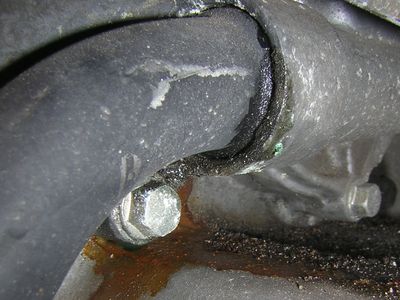 ... leaktrail ... | |
|
Th CX was waiting patiently for the thing to come, and that Tuesday
afternoon it was time to put a spanner into the engine.
At first I had to make sure that I can could reach the place where the fan was mounted. That meant that firstly the lowers of the fairing, and afterwards that fancy Polaris fairing itself had to be removed. As soon as that was ready, the radiator protection of the fairingbrackets was removed. Next the petrol tank had to be taken away. And of course I had the CX completey filled up with petrol, and such a tank full with petrol weights a lot more than a tank which is almost empty. But when these tasks were done, the CX was ready for the largely unknown part of the operation. At least, I thought... The next thing to do was to drain the coolant from the radiator. Simply, by means of the drainplug to the base of the radiator. Several hoose clamps were loosened in advance whereas the coolant, still clear blue, into a container ran. The coolant was put in in February 2008, when the " Red Rascal" after the stator replacment, was put together again. According to 'Peter's' the coolant must be replaced each two years, but a bit sooner will not be an disaster. | |
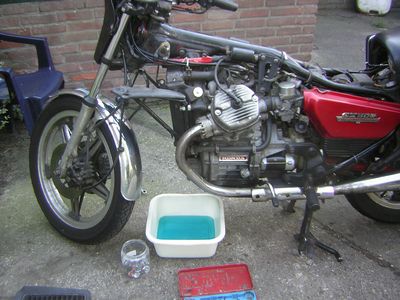 ... clear blue ... | |
|
While I drink a cup of tea the last drops run from the cooling system.
When I return to the motor I start extracting the radiator. But that
not so simple!!! Three bolts that hold the radiator in plce are easely
loosed. The tubes can be pushed aside rather easily, but then, if
I want to take the radiator out, I see that teh polaris supports right
and left are blocking the space. There not escape, I have to remove
the fairing support also.
| |
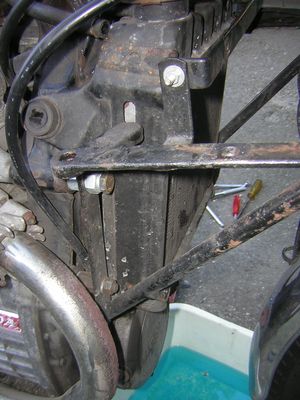 ... right fairing mount... |
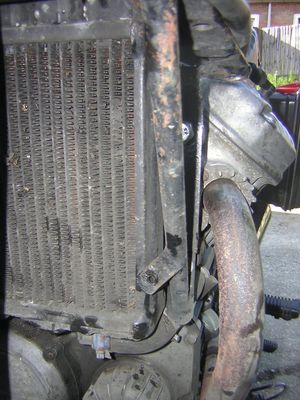 ... left fairing mount ... |
|
Well then, what must be, must be. I put one water-hose in place,
so the radiator does not hang loose, and remove the fairing support.
It goes in fact smoothly, so far, and when I have removed both the
fairing supports it is possible to take the radiator simply away.
A couple of drops coolant still drizzle in the container under the engine,
but on, I had counted on that. And whem I put the radiator on a safe spot
I can look at what the problem must be.
The cratches on the plastic fan-blade don't worry me at all, but there are also a few cracks visible, and those could well be the cause of the stange sounds. Even if the plastic is only a litte loose from the aluminium heart of the fan, strange things can happen inside the dark regions of the engine, hidden behind the radiator. Now first I have to loosen the securing bolt to get to the fan. That goes easy. Then it is time to use the fan release bolt, which I have since SJK 2008, "just in case....". And now I have that case here. The bolt is put into the center of the fan. It is also possible, according to handbook and innumerable stories on the CX-club site, to used the front axel. But I also have heard and read tales about fan's who are stuck onto cone-shaped front of the camshaft, and that with much effort and a dremel, had to cut loose. Moreover, the front axel still holds the frontwheel at this time. So I use the relase bolt. A short moment of "does it go or not" , a short turn to the spanner 19 and with a soft 'plop' the fan is loose, and can be taken of the front of the camshaft. | |
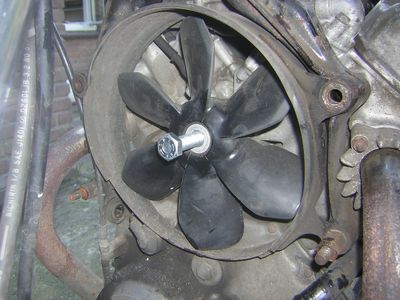 ... release bolt in place ... | |
|
And now I want to see what is wrong with this fan. scratches, ah, that
is nothing, but tears are much more awful. The old fan shows many
cracks and tears. Two or three run entirely through the plastic. Not well,
I conclude. After I have marked the removed fan, I put the 'new' one
next to it. This one is still somewhat dirty, thus firstly I have to
clean it. And then I see something what I had not see earlier.
This fan has also a tear. Only one but, even it is a small one, it
seems to go through and through. Not big, like I said, but nevertheless....
I have to think this over, and some advies is also welcome. Maybe Theo is at home... A couple of hours later I call Theo. He is at home, and I can come to him to present the problem. And so I stand 10 minutes later at his door. We examine the old fan of the "Red Rascal", which really has many cracks, and the newer one, with one small mini-crack. What to do? We agree that this small crack is not really fine, and that a new fan would be much better. But where do you obtain a new fan? Theo has also some reserve fans, but those both are extracted with the front axel, and have now a damaged center piece. But there also is a demolition engine, stuck, but with a reasonble good looking fan. If we can take that away now and see how good it is? Theo's workshop, in spite of a vast and a terrible good provided tool cupboard, has no fan extractor bold. Do we try it with a spare front axel? Better not, so I go home to get the extractor bold, tha's on my desk. Half an hour later I sit at the demolition engine, where in the meantime the securing bolt for the fan is removed. Bolt in place, spanner 19, and ' plop', the fan is loose. I get already some experience ...... We bekijken de fan en maken het plastic rond het hartstuk schoon. Deze fan is in een bijna nieuw-staat. Nergens, maar dan ook nergens een kras, scheur of pit te bekennen. Ik laat de fan uit Nijkerk achter bij Theo, en ga naar huis met een scheurloze ventilator in de tas. We examine the fan and clean the plastic around the aluminium center piece. This fan is almost new. Dirty, that too, but nowhere scrape, crack or tears to see. I leave the fan from Nijkerk at Theo, and go home with a crackless fan in the case. | |
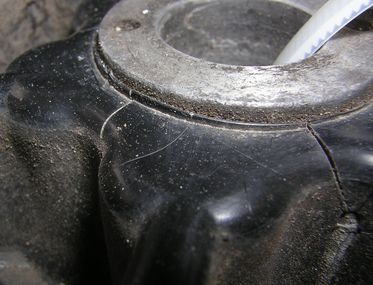 ... from the Rascal ... |
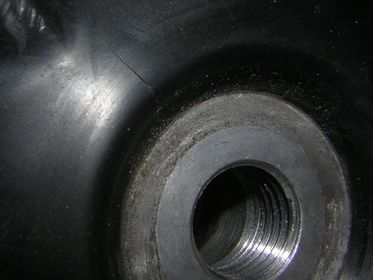 ... mini-crack ... |
|
Two days later, thursday afternoon, I continue. The first part
was the disassembly of the suspicieus fan, the second part is
the rebuild. The fan is clean, the conic part of the camshaft is clean
and there it goes. I put the fan in plce, and push a bit on it.
The result is very satisfiing, because the fan is fixed at once.
A tied fit. The securing bold is put in place and that is ready.
Weel, almost ready. radiator, fairing support, petrol tank, all the parts
that first were removed must put back together again. There are some
problems with the radiator, but when I find out that I am doing
something wrong, I correct the mistake, and that's that.
Als ik de radiator goed heb, kijk ik ook nog even naar het andere probleempje, de waterpijp. Wat te doen? Ik veeg met mijn vinger het lekspoor weg. Hé, denk ik, wat gek. Want het lekspoor is vettig, en lijkt meer op olie dan op koelvloeistof. En de koelvloeistof die uit de motor kwam is lichtblauw, en dit is eerder bruin. Als de waterpijp zou lekken zou het lekspoor logischerwijs ook blauwig moeten zijn. Hmmmmm... De bruine streep kwam tevoorschijn in Belgie, en terug uit Belgie was het oliepijp beneden het minimum gezakt. Ik hou het even op olie, die daar ergens uit het blok kan komen. Ik waag de gok, en besluit de waterpijp niet los te halen. If I have the radiator wfitted in place, I take a look the other small problem, the water pipe. What to do? I sweep with my finger across the leak-trail. Hé, that is crazy. Because the leaktrail is somewhat greasy, and seems more oily than coolant. And the coolant which came from the engine is pale blue, and this is more brownisch. If the water pipe would leak the leaktrail must be blue. Hmmmmm… The bruine line came visible in Belgium, and returning from Belgium the oil level had fallen below the minimum. I convince myself it just oil, which can come there from somewhere on the back of the engine. I dicide not to take the waterpipe loose. Now the radiator is in place again, the fairing supports are mounted. The old cooling liquid goes into a bottle to put into the chemical waste, and new liquid goes in the radiator. It look as if I can poor less liquid in, than there came out, so I musat remember to check it in a few days. | |
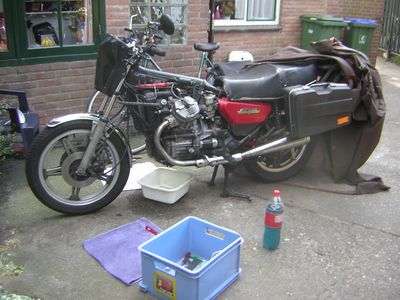 ... fairingmounts in place ... | |
|
And now everything is open and accesseble I also can take a look how
the valve-settings are. The last time these where checked was, as far as
I know, in March, when the frame was checked and repaired and the oil
refreshes. And now I am further in time and space, 6 are months and
more than 5000 kilometres. According to ' Peters' I have to control
the valve-clearing each 4 months or 6000 kilometr, and the one is
over and the other one has not come. Therefore: valve check.
That proves be indeed no luxury. The exhaust valves stand at more than 0.12 to 0.15 mm. Inlet side are somewhat better adjusted, but here too is sufficient space for improvement. After resetting the valve-adjustment to the right values, the lids are put bachk on, and whta is next? I decide to test the engine. The tank is not yet in place, but there must be still enough fuel in the carburetors, the petrol tube and petrol filter. To my large surprise and joy the CX starts after just one push at the start-button. No choke, no problems. It has been differently lately, if I had to start in the morninge, I had to pull the choke and had three, four, five turns before the " Red Rascal" started. Now it goes direct. Thus valve control has it's rewards. The following step is the fairing. And now with good, original rubbers, and not with a piece of folded innertube. Looks much more neater, and are at least as well. The petrol tank goes up there, the Polaris on the spot, lowers , electra connected and then it is time clean up the tools, and think about what I might have forgotten. I can't think of anything, and that evening it is time for a very smaal test-ride. No strange sounds, nicely muttering engine, everything seems to work as it should do. The next day it's possible to ride the bike to work again. Whereas kilometres passing under me I listen to the sound the engine makes Nothing flaps, no annoing sounds. A job well done. Only that small leak is not done yet, but that is for other time ...... | |
|
| |